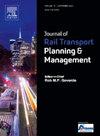Integrating AI and edge computing for advanced safety at railroad grade crossings
IF 2.7
Q3 TRANSPORTATION
Journal of Rail Transport Planning & Management
Pub Date : 2024-12-24
DOI:10.1016/j.jrtpm.2024.100501
引用次数: 0
Abstract
The integration of artificial intelligence (AI) and machine learning (ML) into the Railroad High-Grade Crossing (RHGC) systems represents a significant milestone in enhancing both safety and operational efficiency. The fusion of various technologies enables the seamless integration of real-time identification, accurate forecasting, and prompt reaction to pivotal traffic situations. This research introduces a state-of-the-art architecture based on edge cloud technology. It integrates advanced computer vision algorithms for object detection and segmentation with a custom dataset for RHGC safety. In the proposed novel framework, we utilize a Weighted box- Fusion (WBF) ensemble approach, integrating diverse object detection algorithms, such as YOLOv8M (medium), YOLOv8L (Large), and YOLOv8X (extra-large), to enhance the detection of safety measures at RHGCs objects. Moreover, we incorporate a UNet segmentation model to identify trains approaching the RHGCs. The amalgamation of these methodologies leads to a fully automated, AI-driven safety mechanism for RHGC. The edge-cloud architecture is employed, with surveillance cameras linked directly to an edge server strategically positioned at grade crossings. This arrangement facilitates real-time data processing, ensuring efficient bandwidth usage and minimal latency by relaying only the necessary processed information to the cloud. Our ensemble model demonstrated an impressive precision rate of 97%, with the segmentation model achieving a higher rate of 98%. This system establishes a novel standard within the discipline, amalgamating artificial intelligence, edge computing, and cloud technology to significantly augment safety and efficiency at grade crossings.
集成人工智能和边缘计算,提高铁路平交道口的安全性
将人工智能(AI)和机器学习(ML)集成到铁路高等级道口(RHGC)系统中,是提高安全性和运营效率的重要里程碑。多种技术的融合,实现了对关键交通状况的实时识别、准确预测和快速反应的无缝集成。本研究介绍了一种基于边缘云技术的最先进架构。它将用于对象检测和分割的先进计算机视觉算法与用于RHGC安全的自定义数据集集成在一起。在提出的新框架中,我们利用加权盒融合(WBF)集成方法,集成了多种目标检测算法,如YOLOv8M(中型),YOLOv8L(大型)和YOLOv8X(超大型),以增强对rhgc目标安全措施的检测。此外,我们结合了UNet分割模型来识别接近rhgc的列车。这些方法的融合为RHGC带来了一个完全自动化的、人工智能驱动的安全机制。采用边缘云架构,监控摄像头直接连接到位于十字路口的边缘服务器。这种安排促进了实时数据处理,通过仅将必要的处理信息转发到云,确保了有效的带宽使用和最小的延迟。我们的集成模型显示了令人印象深刻的97%的准确率,分割模型达到了98%的更高准确率。该系统在该学科内建立了一个新的标准,将人工智能、边缘计算和云技术相结合,显著提高了平交道口的安全性和效率。
本文章由计算机程序翻译,如有差异,请以英文原文为准。
求助全文
约1分钟内获得全文
求助全文
来源期刊

Journal of Rail Transport Planning & Management
TRANSPORTATION-
CiteScore
7.10
自引率
8.10%
发文量
41
 求助内容:
求助内容: 应助结果提醒方式:
应助结果提醒方式:


